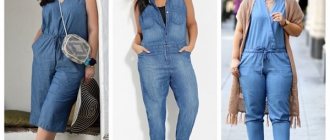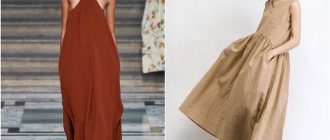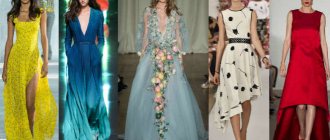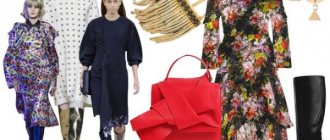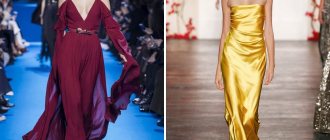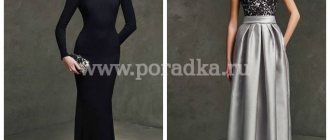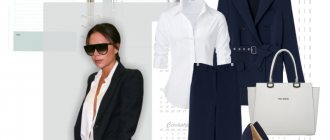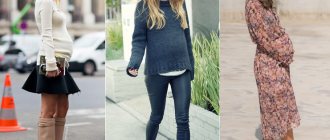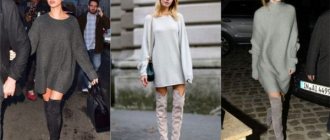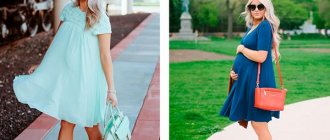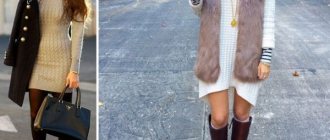Dictionary of fashion terms
Fashion constantly creates new terms and forgets old ones. Every season, new items that come into fashion make us remember some words and consign others to oblivion. Names such as “hairatnik” or “dolchiki” today can cause bewilderment among young ladies and nostalgia among those who still remember what they mean. To be sure of the names of certain forms of clothing, refer to our brief dictionary of fashion terms.English costume
Initially exclusively a men's suit, considered a traditional, conservative, sustainable set of clothing suitable for working in a business environment, in the office. It originally arose in England in a bourgeois environment at the end of the 18th - beginning of the 19th centuries. Consists of a jacket, trousers and vest. Complete with a formal shirt, tie and shoes. Made from worsted (suit) fabrics of dark color (dark blue, dark gray). The English suit entered women's clothing at the end of the 19th century. (See “A Brief History of the Business Suit”) Initially it consisted of a straight skirt and a jacket-type jacket (lined with a turn-down collar and lapels). Fabrics in stripes, checks and plain, soothing colors were used for it. The English suit is a fashion classic of the 20th century. Once it appears, it does not lose its relevance, but its proportions, silhouette, shape of pockets, collar and lapels change periodically.
Blazer
(English Blazer) Club jacket. Classic cut jacket, single or double breasted. The main feature of a blazer is metal buttons - enameled or with the image of the owner's coat of arms, club emblem or naval symbols. Other distinctive features include a patch chest pocket with an embroidered club badge or crest and contrast piping throughout. Legend attributes the invention of the blazer to the captain of the royal frigate Blazer. On the occasion of Queen Victoria's visit in 1837, he dressed the ship's crew in dark blue, double-breasted jackets with six large gilt buttons. The new uniform was approved by Her Majesty and quickly spread to other ships. Since the 19th century the blazer became the uniform of English rowing clubs. In the 20th century It became part of the uniform in English girls' schools. Since the 1920s became widespread in women's wardrobes, and has regularly come into fashion for over a century. The color of the blazer is usually dark blue, although blazers of other colors are also available. According to the rules, it is combined with trousers of a lighter shade - white, cream. The women's version may have a skirt instead of trousers, but also in a much lighter color.
Blouse
(French Blouse) Women's shoulder-length outer clothing, hip-length, with long or short sleeves. It can be hinged or have a short clasp. There are also options without clasp. Its origins date back to the 1880s, when ladies complemented their wardrobe with a men's shirt. Women's blouses became an independent type of clothing, and very elegant versions appeared, trimmed with lace and embroidery, which became the actual “blouse,” although the name was fixed later. They were worn paired with a long skirt or as part of a suit. An English blouse (with a high stand-up collar) made of cotton, linen, and silk was also called Victorian. Blouses with a slanted collar in Europe were called Russian. Blouses are made from thin materials - cambric, chiffon, crepe de Chine, charmeuse satin and thin jersey (knitted fabric). The blouse is an integral element of a classic women's suit. Today there are shirt blouses (reminiscent of men's business shirts), blouses themselves (differing in more femininity, soft fabrics and designs, neckline) and tops - open blouses without sleeves, with straps or bustiers.
Bolero
(Spanish: Bolero) A short jacket that extends above the waistline, usually without a fastener, often with rounded edges. Originally - the jacket of a Spanish bullfighter. It is sewn from a variety of fabrics, knitwear or woven from lace. Often serves as an addition to a dress with an open top.
Breeches
(English Breeches - wide short pants) Loose trousers just below the knee, usually with cuffs. They tightly cover the calves of the legs below the knee, and are made quite wide at the hips. Initially used for sports and hunting, they were made from woolen checkered fabrics or tweed.
Trousers
(borrowed from Low German Brok or Goll. Broec - pants; the word came into use during the reign of Peter I) Belt clothing covering the legs, each separately. Trousers are of Eastern origin and were originally worn by nomadic peoples for horse riding. In its ancient form, the dhoti (a piece of cloth wrapped in a special way around the legs) is still in use in India and Pakistan. In Europe, trousers underwent a long evolution and were known under different names - pantaloons, culottes, breeches, etc. Since the 12th century, trousers have been considered exclusively men's clothing and are strictly prohibited for women. For the first time, women's bloomers trousers (named after Amalia Bloomer, who herself wore them and popularized them in her magazine) - a type of bloomers - appeared in the middle of the 19th century, and by the end of the century they were widely used for cycling, but were still condemned by the public. The turning point occurred during the First World War, when women, who replaced men in many jobs, began to wear men's clothing, including trousers. From this moment on, women's trousers are actively spreading in Europe and America, but for now they are classified as clothing for sports and leisure, remaining prohibited in the urban environment. The legalization of urban women's trousers, as well as the women's trouser suit for the office, occurred thanks to Yves Saint Laurent in the late 1960s. Modern classic women's trousers have two front and two back panels connected by seams, as well as a front or side fastener. These trousers are cut from suit fabrics, straight or slightly tapered, and have pressed creases. Classic trousers are also often equipped with tucks at the waist and cuffs at the bottom of the legs. Along with classic business trousers, modern fashion has a wide range of other forms of trousers, many of which have their own designation - capris, breeches, cargo, etc.
Bustier
(French Buste, English Bustier) A blouse-top or dress with an open top and strapless. Usually it fits tightly to the figure and can even be based on a corset. As a piece of underwear, the bustier has been known in various forms since the beginning of the 19th century. Popular in the 1950s, the bustier came back into fashion in the 1980s as evening wear. Since that time, it has become possible to wear a bustier with a suit, under a jacket, or on its own. Today, bustier dresses are common, especially elegant ones, for special occasions.
Evening Dress
Full length formal dress. Along with the floor length in the 1950s. A “ballet-length” dress came into fashion - up to ankle level. Evening dresses are made from elegant fabrics - satin, velvet, lace - and decorated with rhinestones, feathers, embroidery, applique, etc. According to the rules, elegant high-heeled shoes, a clutch handbag, high gloves and jewelry with natural stones are required for an evening dress, but today these rules can often be neglected.
Business suit
Symbol for a men's or women's classic suit for office work. In the Euro-American tradition, there are strict rules and restrictions dictated by business etiquette and regarding the shape, color of the suit and accessories and their combinations (See the section “Dress codes and whether they must be observed”). A women's business suit consists of a jacket, skirt and shirt-type blouse. The pantsuit for women working in an office is an acceptable alternative, legalized by Yves Saint Laurent in the late 1960s. A women's business suit can be blue and gray, beige and sand colors are allowed. The blouse should be light, preferably without a pattern. At the end of the 1990s. There has been a trend towards democratization of the business suit. It has become possible to deviate from the blue-gray palette, especially in women's clothing, where all light, pastel colors and some bright colors are allowed. In some cases, you can replace the shirt with a blouse or knitted jumper or pullover. For office work, black or brown shoes with moderate heels are recommended.
Jacket
(English Jacket) Predominantly women's outerwear with sleeves and length ending from the waist to the middle of the hips. The same as a jacket in men's clothing. There are many options. Types of jackets - cardigan, tuxedo, blazer, etc. Today, jacket is the most general designation for various types of men's and women's clothing.
Jacket-coat
Jacket made of coat fabric. A type of elegant urban outerwear. Can be combined with a skirt made of the same fabric (in this case we can talk about a coat suit
Safari jacket
A jacket made of linen or cotton fabric with four patch pockets with flaps, a belt with a buckle, and often with shoulder straps. A safari jacket usually has a stand-up collar or, less commonly, an English collar. Initially, the safari jacket was used by the British military in the colonies, and therefore has a characteristic shade of beige and sand. At the end of the 1960s. The fashion for safari style was initiated by Yves Saint Laurent. This jacket is usually combined with a straight skirt, trousers or shorts. Sometimes there are safari dresses, which are an elongated version of the jacket. Today, the safari jacket and safari style are a classic in an elegant women's summer wardrobe.
Vest
(French Gilet) Outer swing shoulder garment without sleeves or collar. Originally, it was a type of men's clothing worn under a camisole over a shirt. Along with the tie, the vest for a long time remained the only bright detail of the men's toilet; only its color and, to a small extent, style changed. At the end of the 19th century. women have made the vest part of their wardrobe. In the 1960s The vest has become part of the modern informal wardrobe. Various versions of it were created, some of which were borrowed from the East and Africa.
Capri
(based on the island of Capri in Italy) Tight-fitting narrow or straight women's trousers, just below the knee or mid-calf length, which came into fashion in the 1950s. Sometimes capris are equipped with small slits at the bottom of the side seams. According to legend, the invention of Capri pants is attributed to Emilio Pucci, an Italian designer who had a factory on the island of Capri where they were produced. In addition, Capri in those years became a popular resort, where such trousers were actively worn, for example, by American tourists.
Cocktail Dress
Or a cocktail dress. Elegant knee-length dress of any design. It differs from evening wear not only in length, but also in less expensive fabrics and more modest decoration. The cocktail dress came into fashion in the 1920s, during Prohibition and the Jazz Age. Young women wanted to look smart, but less formal and more dynamic. Such a dress was then complemented by a fur boa or coat, which made up an ensemble with it. Today, a cocktail dress can be complemented with a jacket (for example, a bolero) or a stole.
Little black dress
A popular form of formal sheath dress, as well as cocktail dresses. Legend credits its invention to Gabrielle (Coco) Chanel in 1926, but many designers developed similar designs almost simultaneously after World War I, when black transitioned from a funereal color to an everyday color. For example, Jeanne Lanvin created such dresses back during the war, and Chanel herself began using black in dresses already in 1919. Throughout the twentieth century. The dress has undergone a number of changes, becoming a symbol of feminine elegance. The classic shape of the little black dress is a simple, body-hugging, knee-length dress with long sleeves. Business and cocktail forms of a little black dress can be sleeveless and even with straps. The material of the little black dress can be anything, but its black color remains unchanged.
Blazer
(English Pea-jacket) Men's shoulder swing clothing, a jacket of a semi-fitting or straight silhouette, with long sleeves and an English collar, button closure and pockets (usually welt). Often one or two vents are made on the back of the jacket, and the waist is cut with cut-off barrels. The jacket serves as the basis for many forms of men's and women's jackets - blazer, tuxedo, etc. The word “jacket” in the Russian colloquial tradition is also applied to women’s jackets of the blazer type.
Dress
A form of women's clothing that covers the entire torso and legs, sometimes down to the floor. The dress can be cut at the waist (in this case it consists of a bodice and skirt sewn together) and one-piece; with sleeves of any length or without them (a dress with an open top without straps is called a bustier dress), with any other details. Along with open dress forms, there are dresses-robes, dresses-shirts, dresses-aprons, dresses-coats. A dress with an open top and straps is called a sundress in Russian colloquial tradition. Presumably the dress originated from the tunic of ancient times and the simplest undershirts of the early Middle Ages. According to another version, it comes from Asian clothing such as a caftan. In Europe, the first women's dresses resembling modern ones appeared around the 12th century, when the development of intricately tailored clothing began. Throughout history, the dress has taken on various forms. In the 20th century, dresses were divided according to functionality - wedding, elegant, cocktail, casual, business, etc. Many dresses have enduring names, for example, little black dress, princess dress, etc.
Coat dress
An elegant swing dress with a through fastener from top to bottom, reminiscent of a city coat in design. It differs from a coat in lighter (dress, suit) fabrics. The coat dress was very popular in the 1950s and today can be used as office wear.
Princess dress
A stable designation for a dress with an hourglass silhouette - with a very narrow bodice and a full skirt. It became most widespread in the late 1940s and early 1950s. and is associated with the new look style of Christian Dior.
Dress shirt
A dress with sleeves and a fastening to the waist, often with a belt. This cut has been known since the 1920s, when Gabrielle Chanel's little black dress was cut this way. A dress with buttons from top to bottom, reminiscent of a men's shirt, came into fashion in the 1960s.
Apron dress
A swing dress with a large wrap around the back that wraps around the figure. May look like a sundress.
Sheath dress
A narrow dress with a fitted or semi-fitted silhouette. Often sleeveless and with a small neckline, usually the so-called classic length - to knee level. Often used as a business dress, which can be worn with a jacket instead of a skirt. Sometimes a sheath dress is complemented by a blouse or jumper that is worn underneath it.
Swinger
(English Swinger) A jacket or jacket-coat of a trapezoidal silhouette with a strong flare down the back. The length of the swinger varies from the waist to the hips and even below.
Top
(English Top - top, upper part) Designation of any short (to the waist) piece of light women's clothing. In a narrow sense - a tight-fitting T-shirt with or without straps.
Trench coat, trench coat
(English Trench coat - “trench coat”) A military raincoat, which was originally produced by the English companies Burberry and Aquascutum from specially developed gabardine fabric. Trench coat is a straight double-breasted coat with an English collar that can be buttoned under the neck; with a flying yoke and shoulder straps; welt pockets and a belt with a buckle. There is usually a slot at the back. The trench coat first came into widespread use during the First World War, when women first began to wear it. It was very popular in the 1930s and 1940s thanks to film stars such as Greta Garbo and Humphrey Bogart, who often appeared wearing the trench coat on camera and in real life. The trench coat was given a second life by Yves Saint Laurent, who introduced it into fashion in the late 1960s. Today, the trench coat is considered a must-have item and has become a classic of elegant women's clothing.
Tunic
(Latin: Tunica) A straight shirt or dress, mid-thigh or knee-length, usually without a collar and with slits on the sides. Worn as an independent type of clothing or in a set with a skirt or trousers. Goes back to ancient Greek and Roman clothing.
Skirt
(Polish jupa from German Jope, Jupe and French jupe - skirt) Belt women's clothing, covering from the waist to the bottom of various lengths, as well as part of a woman's dress, cut off along the waist line. The skirt is one of the most ancient types of clothing, both men's and women's. Skirts can be straight, tapered or flared. The skirt can be cut from 2, 4, 6, 8 or more fabrics. A special case is the circle skirt (cut in the shape of a circle with a hole in the center for the waist) or the circle skirt (cut from a segment of a circle). Some types of skirts have stable names.
Skirt year
(French Godet) A skirt that fits tightly at the waist and hips and widens downwards from the middle of the thigh or from the knee. Usually cut with wedges or with wedge-shaped inserts
Pencil skirt
Knee-length tapered skirt. Can be part of an office suit. For ease of movement, it is usually equipped with a slot or cut.
Straight skirt
A narrow skirt that falls from the hips perpendicular to the floor, usually knee-length or higher. A straight classic skirt with a vent is part of a women's business suit.
Tulip skirt
The skirt flares out from the waistline, is full at the hips and tapered at the bottom. Typically knee length or higher. The fullness in the hips can be provided by gathers, pleats or tucks. Sometimes it is cut with a wrap. Top
Fashion dictionary
Argyle - is a pattern of geometric shapes such as squares and diamonds, which are located diagonally at the intersection of diagonal lines. Argyle was the hallmark of the plaids and kilts of the famous Campbell clan from Scotland. And the pattern itself began to be called that because of the name of the area where this clan lived. Argyle gained the greatest popularity in the manufacture of knitted items. The pattern became famous in the 1920s, it was used by the Pringle of Scotland company from Britain, which produces luxury knitwear and knitwear. The argyle pattern and V-neck are classic British style.
Alpaca is an animal from the camel family. High quality yarn is made from the wool of this animal, which is superior in characteristics to sheep. Things made from alpaca are stylish and refined, pleasant to the touch, warm, have a long service life, light, durable, practical and attractive.
An ascot is a tie with wide, pointed ends. This is the main accessory of British aristocrats and is the main requirement of the royal horse racing dress code.
A buggy is a type of jeans that has a baggy shape. They are worn lowered so that the underwear shows. Especially popular in America among African-American teenagers.
A blouse is a type of blouse whose dimensions correspond to the size of the bra. The blouse got its name thanks to Brigitte Bardot.
A bateau is a cutout that is shaped like a boat.
Bermuda shorts are long, loose shorts that reach above the knee. They are worn not only on vacation, but also in offices with flat shoes or classic pumps.
Bispok – tailoring of clothes to personal order, with strict consideration of personal wishes.
Black tie is a dress code for clothing that is worn for special events at social official receptions. Tie and tuxedo are required.
Bolo is a tie in the form of a lace. The lace has a clip with an ornament or an original knot.
A bomber is a short jacket with a zipper. It has elastic inserts. Such inserts are the collar, cuffs and bottom of the jacket. Bomber is a type of unisex uniform.
Borsalino is a soft felt hat with a wide brim. If the hat is rolled into a tight tube, then it can be pulled through a wedding ring without getting wrinkled.
Ankle boots are shoes in the form of boots or ankle-length shoes of various shapes.
Brogues are shoes with closed or open lacing, the top of which consists of several elements and is decorated with perforations.
A boutonniere is a wedding decoration in the form of a flower or several buds that are inserted into the buttonhole of a jacket.
Wayfarers are iconic glasses that have plastic or horn frames and have been produced since 1952.
Vicuna is the most expensive fabric in the world, it is made from the wool of the vicuña (a type of llama). Llamas lose their fur naturally. All the collected wool is enough for 100 suits a year.
Winkle picker - boots with a straight sole and a pointed toe.
A regatta tie is a tie whose knot is made in a factory, with a rubber band and a clasp located at the back. The ribbon is hidden under the shirt collar.
Guideline – corporate style, memorable detail.
Gaiters are a piece of clothing knitted or made of knitted fabric, worn on the legs; the length of the gaiters can reach the knees or feet. Previously intended to protect shoes, they are now a stylish accessory.
Leg warmers are products that are made using hand or machine knitting. Gaiters are for legs. Product length from ankle to knee.
Gladiators are flat sandals of varying heights. They have a huge number of interlocking straps.
Loveletts are fingerless gloves, up to the elbow.
A boa is a small scarf made of natural fur with the head, tail and paws of the animal from which it is made.
A duffle coat is a three-quarter length coat with a voluminous hood, large wooden buttons and side patch pockets, as well as large leather loops or cords.
Deserts are men's boots made of suede and having a crepe sole. Distinctive feature: there are only two pairs of holes for laces.
Derby shoes are Oxford shoes made of suede leather or nubuck with a small wide heel and an elongated pointed toe. They have boots sewn on top of the vamp, as well as open parallel lacing. Derby has decorative trim from straps, figured stitching or decorative buttons.
Jute sole is a fashionable and unusual sole, made from natural and ecological material of the jute plant of the Malbaceae family.
Dorsay is a style of shoe in which the arch of the foot is open, and the heel and toe are closed.
Cape is a cape of different lengths, sewn from various fabrics. It has a trapezoidal shaped opening for the hands and a clasp at the neck.
Gatsby cap is a men's hat with a folded hard visor, a tall soft cap made of eight sewn parts. A button covered with material is sewn together connecting all the parts.
Creepers are low shoes with a high platform (5-8 cm) with a solid sole in various colors.
Clutch (Klatch) is a small bag for women in the shape of an envelope. Often has a small handle and no strap. The klach is worn under the arm, or clasped with the palm.
Loafers are shoes that are very similar to moccasins without laces, have a wide low heel, and leather tassels that are decorative elements.
Martins are rough boots with laces, very wear-resistant, made of waterproof leather, available in various colors.
A menadiere is a small bag worn on a chain or long strap over the shoulder.
Menudier is a style of clutch that is shaped like an elegant box. This is a stylish accessory with a rigid frame, decorated with embroidery, beads, mirror glass, and multi-colored stones.
Mitts are original gloves that have no fingers and are held on the limb using interdigital bridges. There are many models, for example, openwork mittens for a wedding dress, practical mittens, or simply warm mittens.
Moccasins - flat-soled shoes are comfortable, soft, made of suede or good leather without laces.
Moonboots are very warm shoes designed for country walking.
Mules are open shoes without backs; the toe of this model is decorated with rhinestones, laces, and framed with leather.
Norfolk - a jacket for hunting, reaching the length of the hips, has two folds on the back, large pockets with flaps in the front, and a belt sewn on the back.
Oxfordettes are shoes made in the English style. Their calling card is a rounded, slightly elongated toe, as well as closed lacing, decorated with perforations. This type of shoe is similar to derby. The sides are sewn under the bottom of the front of the shoe - this is a difference from derby.
Pannier is a frame that was made from steel or willow rods, as well as from whalebone plates. Panniers were used to add fullness to a woman's skirt.
Parasol is a French umbrella, handmade for protection from the sun and rain. This umbrella is decorated with lace, beads, and bright fabrics.
Paisley is a design that is called the Indian cucumber or palm branch. It is applied to scarves, shawls, shawls. The shape of the pattern resembles a sprouted grain or an embryo. This configuration represents a symbol of energy, dynamics, development. Silk men's paisley ties are currently very popular. At the peak of modern fashion: leather bags in the design of which this ornament was used.
Preppy is a clothing style whose distinctive features are comfort and neatness. Items are presented by expensive brands. Clothes are made only from natural fabric. In this case, linen, cotton, and wool are used. The attributes here are expensive and elegant. Butterflies on the neck, headbands, and ties are in great demand. Carefully select a shoulder bag; usually it is roomy, but not huge. Main colors: deep blue, yellow, khaki, red. Today, this style is in fashion; many brands have made it their business card.
Prepsters are a mixture of business and elegant styles. Its main characteristics: simplicity, accuracy, comfort. This style has traditional styles, no unnecessary details, and natural fabrics are used. Luxury accessories, no acidic shades, classic colors used. A style that is suitable for successful people, self-confident with an active lifestyle.
Plume is a small bag with an adjustable strap with one removable fabric compartment with a clasp and zipper.
Polo is a men's shirt with a high collar, a slit that is secured with two or three buttons or buttons, and has an additional pocket on the chest. This is a universal wardrobe item for men. Models are made with long or short sleeves, different in color, decorated with various patterns.
A reticule is an elegant bag for women. Laconic models for daily use or evening fashion attributes are produced. The shapes of handbags are tube, envelope or unusual trapezoid. The classic version of the reticule is usually in a dark version. Designers have created models for special events. In this case, the handbag is decorated with rhinestones, sequins, ruffles, metal figures, and buttons.
Clogs are wooden shoes, a prototype of modern shoes with a high vamp line and an open heel. The sides of the vamp cover the foot from the sides to the middle of the heel. All kinds of materials, as well as decor, are used in the manufacture of clogs. The choice of material depends on the style. The base of the sole is a synthetic material, and the side surface is decorated with homespun fabric, wood-like, and imitation of various types of flowering is also used.
A sling is a backpack. It is very easy to wear and dress; the backpack can be worn with either crossed or parallel straps. The model is very ergonomic. The sling is fastened with fastex and padded with foam rubber.
Slip -ons are sneakers consisting of two parts. Canvas is the upper part, and the bottom is a rubber sole. They are very light, without laces. This shoe was created specifically for surfing in 1977. Slip-ons are used for long day walks. The model is universal and can be easily combined with any clothing.
American Ivy League student style - the term first appeared in 1954. The Ivy League is a union of eight US universities. It received this name due to the shoots of ivy entwining the ancient buildings of these educational institutions. Represents the style of golden youth.
Temdera - boots for women with wide tops. Women who tuck their trousers into their shoes will appreciate this model.
Tisheydas are round-shaped glasses with thin, simple frames, laconic. “Granny’s glasses”, “glasses for the blind” are often called this accessory. They became the hallmark of the hippie era. They have strict form and design minimalism. They are the most ancient form of glasses.
Heelies are a type of sneaker with wheels inserted into it. Wearing them, you can walk or ride. The wheels are installed in the heel area, easily removed and replaced with plugs.
Chelsea boots are boots with low flat soles and have a rubber side insert without laces.
Shemiza is a cotton undershirt.
An eglet is a cap made of metal or plastic; it is attached to the tip of a lace. Its main function is to prevent laces from unraveling and make it easier to thread into shoes.
Espadrilles are summer, lightweight shoes, the upper of which is made of thick fabric, and the sole is made of rope jute, as well as straw and grass. This model is ideal for a hot summer, very comfortable, fashionable, and impressive. Espadrilles are shoes for leisure.
